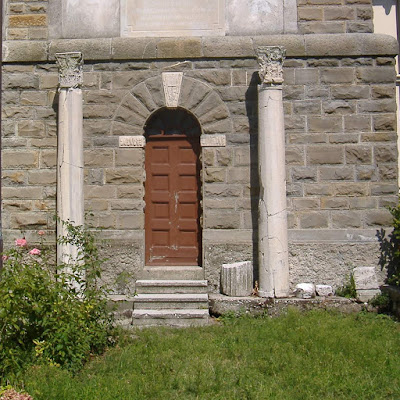Existing in Italy and in Greece today are 13 temples dedicated to Apollo. Six temples are located in Greece; Nicopoli d'Epiro, Thermos, Corinto, Epicurio Bassae, Delphi, Eritria and seven in Italy; Pompeii, Cuma, Syracuse, Metaponto, Palantino, Sosiano and Grado. The more ancient temples present in Greece such as Delphi and Corinto and those of the ancient Greek colonies in Italy, such as Metaponto and Syracuse, are in Doric style while the more recent temples of the Roman times, such as the temples of Apollo Sosiano and Palatina in Rome are Corinthian in style.
In what time period can we then place the Temple of Apollo in Grado, Italy? Archeologists place it in Roman times due to the finding of steles mentioning Apollo-Belenus (Apollo to the Romans and Belenus to the Barbarians) and because of at least two Corinthian columns on the bell tower of what is now a Christian sanctuary on the island of Barbana in the Grado Lagoon. As you can see in the photo (1) there is also a remaining fragment of a Doric column next to the Corinthian columns. It is possible that the Romans simply first built a Doric temple before a more recent Corinthian temple. But it is also quite possible that the Romans constructed a temple dedicated to Apollo on the foundations of a previous temple. Looking at the island of Barbana from aerial photographs and satellite images it is possible to note the outline of an amphitheatre in the lagoon close to the temple (2). An amphitheatre can be found near almost all the archeological temple sites in question. It is interesting to note that the present location of the Christian sanctuary on Barbana and its surrounding grounds outline the same fundamental plans of a typical Apollonian temple. The sanctuary in Barbana seems to be a copy of the temple of Apollo located in Delphi (3) not only for its layout but also for its position in regards to the cardinal directions, for its dimensions, for the position of a possible amphlitheatre in respect to the temple, and for the existence of a small chapel dedicated to the Virgin Mary that is present in the same position as the Athenian Treasury at Delphi. It is also important to note a similar pathway that is present in both locations (4). The Scared Way at Delphi is a path beginning at the front of the Temple of Apollo leading south passing the Athenian Treasury. In Barbana there is a similar path leading from the back of the sanctuary which would have been the front of the temple that passes the Chapel of the Virgin Mary and continues south into the lagoon where a cicular outline can be seen in aerial photos. I believe this (5) is quite possibly the location of the Temple of Poseidon mentioned by Critias in Timaeus by Plato as well as by Homer in The Odyssey which I will explain in further detail in another post. The coordinates of this location are 45 41 56.0 N, 13, 25 35.2E.
Translated from Italian by L. Morrongiello






